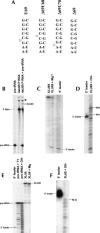The P4 metal binding site in RNase P RNA affects active site metal affinity through substrate positioning
- PMID: 16822954
- PMCID: PMC1524898
- DOI: 10.1261/rna.158606
The P4 metal binding site in RNase P RNA affects active site metal affinity through substrate positioning
Abstract
Although helix P4 in the catalytic domain of the RNase P ribozyme is known to coordinate magnesium ions important for activity, distinguishing between direct and indirect roles in catalysis has been difficult. Here, we provide evidence for an indirect role in catalysis by showing that while the universally conserved bulge of helix P4 is positioned 5 nt downstream of the cleavage site, changes in its structure can still purturb active site metal binding. Because changes in helix P4 also appear to alter its position relative to the pre-tRNA cleavage site, these data suggest that P4 contributes to catalytic metal ion binding through substrate positioning.
Figures



Similar articles
-
Helix P4 is a divalent metal ion binding site in the conserved core of the ribonuclease P ribozyme.RNA. 2000 Apr;6(4):511-9. doi: 10.1017/s1355838200000042. RNA. 2000. PMID: 10786842 Free PMC article.
-
Conservation of helical structure contributes to functional metal ion interactions in the catalytic domain of ribonuclease P RNA.J Mol Biol. 2002 Nov 29;324(3):429-42. doi: 10.1016/s0022-2836(02)01094-x. J Mol Biol. 2002. PMID: 12445779
-
Role of metal ions in the hydrolysis reaction catalyzed by RNase P RNA from Bacillus subtilis.J Mol Biol. 1999 Jul 9;290(2):433-45. doi: 10.1006/jmbi.1999.2890. J Mol Biol. 1999. PMID: 10390342
-
RNase P RNA mediated cleavage: substrate recognition and catalysis.Biochimie. 2007 Oct;89(10):1183-94. doi: 10.1016/j.biochi.2007.05.009. Epub 2007 Jun 2. Biochimie. 2007. PMID: 17624654 Review.
-
Structure of ribonuclease P--a universal ribozyme.Curr Opin Struct Biol. 2006 Jun;16(3):327-35. doi: 10.1016/j.sbi.2006.04.002. Epub 2006 May 2. Curr Opin Struct Biol. 2006. PMID: 16650980 Review.
Cited by
-
Cryo-electron microscopy structure of an archaeal ribonuclease P holoenzyme.Nat Commun. 2019 Jun 13;10(1):2617. doi: 10.1038/s41467-019-10496-3. Nat Commun. 2019. PMID: 31197137 Free PMC article.
-
Solution structure of RNase P RNA.RNA. 2011 Jun;17(6):1159-71. doi: 10.1261/rna.2563511. Epub 2011 Apr 29. RNA. 2011. PMID: 21531920 Free PMC article.
-
NMR and XAS reveal an inner-sphere metal binding site in the P4 helix of the metallo-ribozyme ribonuclease P.Proc Natl Acad Sci U S A. 2010 Feb 9;107(6):2479-84. doi: 10.1073/pnas.0906319107. Epub 2010 Jan 25. Proc Natl Acad Sci U S A. 2010. PMID: 20133747 Free PMC article.
-
Critical domain interactions for type A RNase P RNA catalysis with and without the specificity domain.PLoS One. 2018 Mar 6;13(3):e0192873. doi: 10.1371/journal.pone.0192873. eCollection 2018. PLoS One. 2018. PMID: 29509761 Free PMC article.
-
A divalent cation stabilizes the active conformation of the B. subtilis RNase P x pre-tRNA complex: a role for an inner-sphere metal ion in RNase P.J Mol Biol. 2010 Jul 2;400(1):38-51. doi: 10.1016/j.jmb.2010.04.050. Epub 2010 Apr 29. J Mol Biol. 2010. PMID: 20434461 Free PMC article.
References
-
- Beebe J.A., Kurz J.C., Fierke C.A. Magnesium ions are required by Bacillus subtilis ribonuclease P RNA for both binding and cleaving precursor tRNAAsp. Biochemistry. 1996;35:10493–10505. - PubMed
-
- Fedor M.J., Williamson J.R. The catalytic diversity of RNAs. Nat. Rev. Mol. Cell Biol. 2005;6:399–412. - PubMed
MeSH terms
Substances
Grants and funding
LinkOut - more resources
Full Text Sources
Other Literature Sources
Molecular Biology Databases
Research Materials
